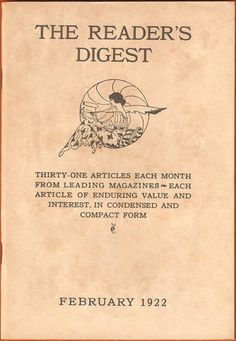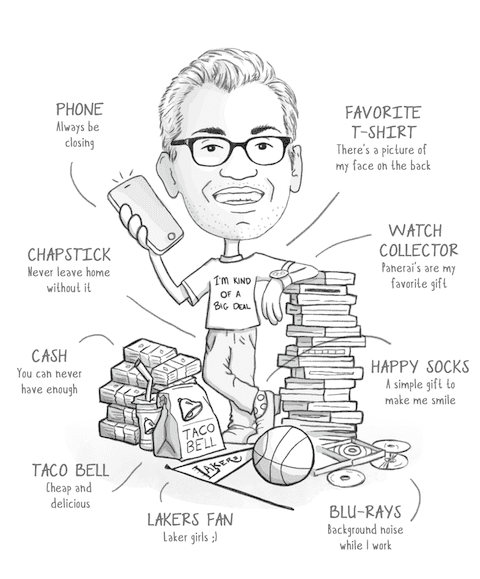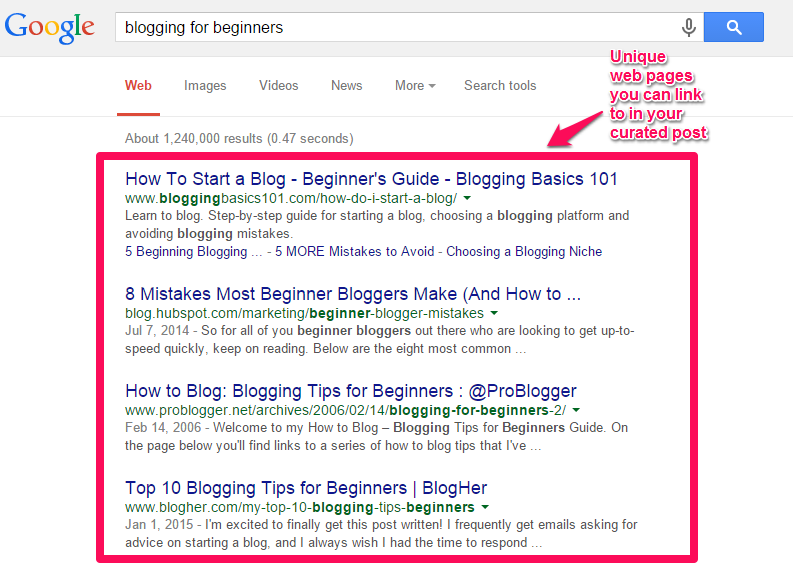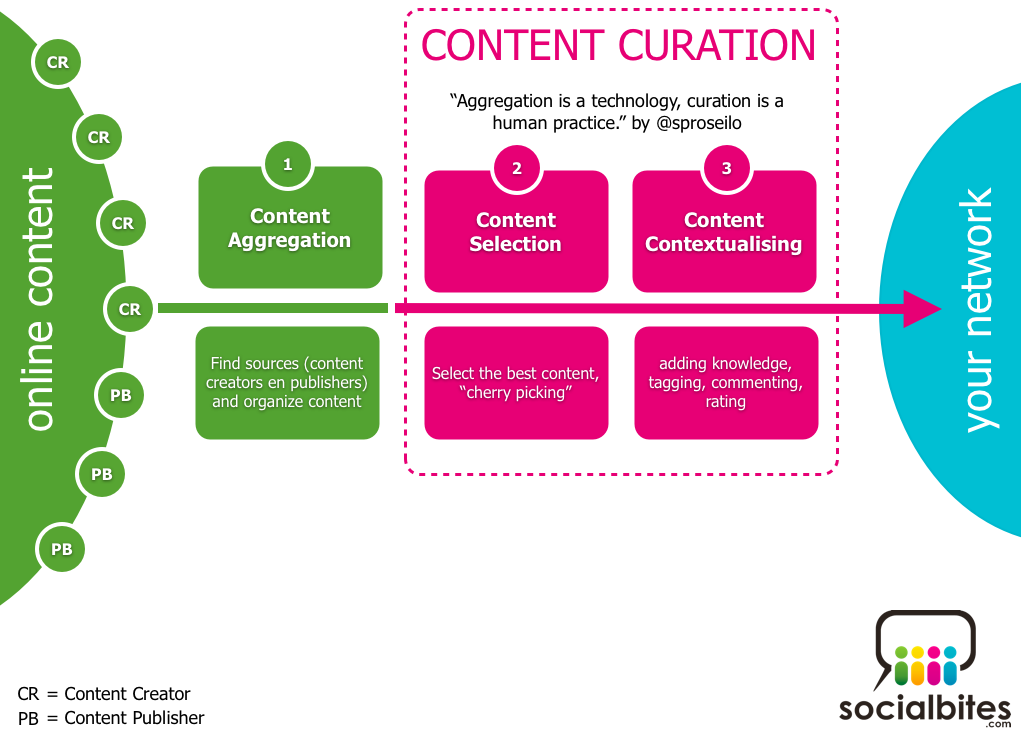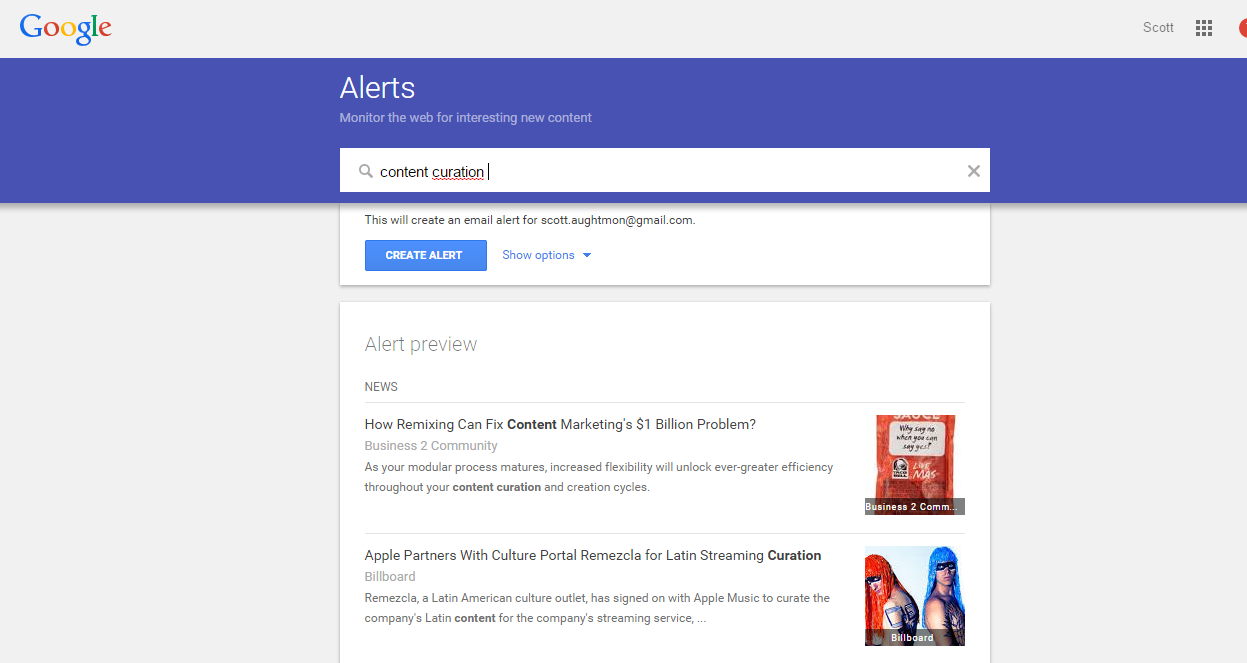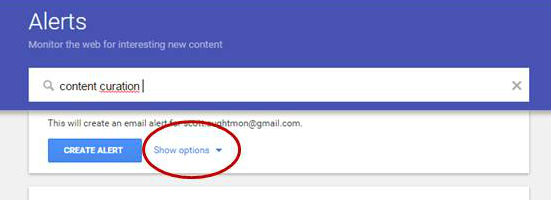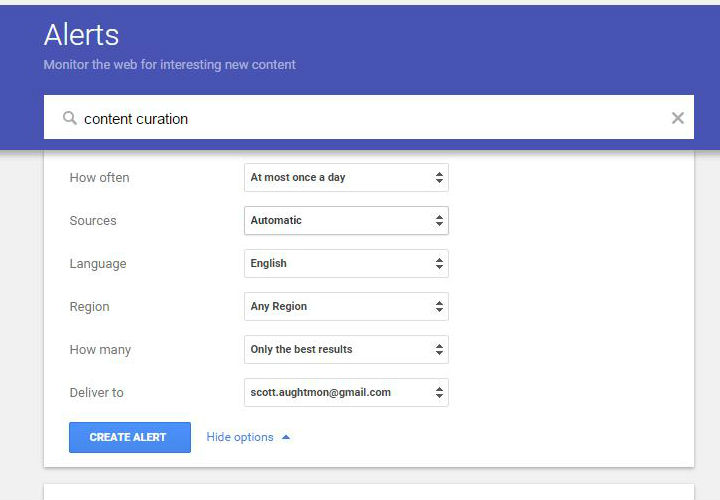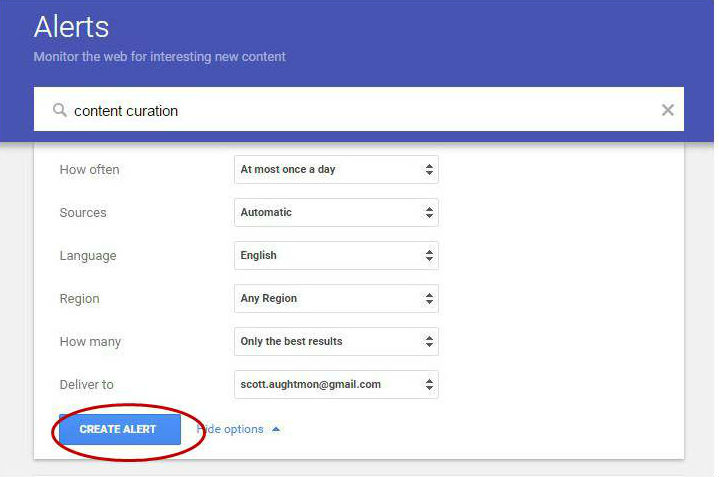Here’s How Neil Patel Uses Curation That Goes Viral

I am about to tell you how Neil Patel went from reselling car parts to becoming one of the top names in content marketing.
And he did it by using an unusual hyrbid method that combines content marketing and content curation in a very unique and powerful way.
But first, I need to tell you an important story.
It’s a story I read in a great book called Curation Nation by Steven Rosenbaum.
It’s the story of how one magazine became the best-selling consumer magazine in the U.S.
And guess how they did this? They used content curation.
(If you don’t know what content curation is, then I’d encourage you to read Beth Kanter’s post Content Curation Primer .)
How Reader’s Digest Was Started
Do you know the story of how Reader’s Digest got started?
The idea for the magazine was thought up by a guy DeWitt Wallace.
He came up with the idea while he was recovering from shrapnel wounds that he received in World War I.
His idea was to gather his favorite articles on many subjects from different monthly magazines.
He would then take these articles and condense or rewrite them and then combine them into one magazine.
His prototype for the first Reader’s Digest issue had 31 articles from magazines like Atlantic Monthly, Saturday Evening Post, National Geographic, and Ladies Home Journal.
He was really pleased with it so he showed a sample of his “magazine of magazines” to the sister of a college friend whose name was Lila Bell Acheson.
She loved the idea! And guess what? He ended up falling in love with HER! He proposed and they were married in 1921.
Together they began a husband-wife partnership that would become what some have said was one of the most successful and productive partnerships in publishing.
The Self-Publishing Route
12 publishers turned them down, so they decided to just produce the magazine on their own.
They mailed out several hundred circulars and then they went on their honeymoon.
When they returned from their honeymoon they were completely shocked!
The results of that first mailing gave them 1,300 subscribers (at $3 a year) for the magazine.
With those subscribers, Reader’s Digest was born.
By 1929, the magazine had 290,000 subscribers and had a gross income of $900,000 a year.
That’s was a lot of money in 1929!
By the 40th anniversary of Reader’s Digest, there were 40 international editions, in 13 languages and Braille, with a total international circulation of 23 million.
That shows you the power of content curation.
The Magazine’s Successful Format
The magazine’s format was used for decades and decades, because it proved to be so effective.
The basic format consisted of these sections:
- 30 articles per issue – This was so there would be one per day.
- A vocabulary page
- A page of “Amazing Anecdotes”
- A “Personal Glimpses” section
- 2 features of funny stories: “Humor in Uniform” and “Life in these United States“
- And a lengthier article that was usually presented at the end of the magazine (This article was usually condensed from a published book.)
How successful was this content curation format?
Well, you can judge for yourself…
Reader’s Digest was the best-selling consumer magazine in the United States up until 2009, when Better Homes and Gardens took that title.
What I want you to see is this.
If you use content curation correctly, it will allow you to produce content your audience loves.
And that leads us to Neil Patel. Why?
Because just like DeWitt Wallace, Neil has figured out a way to harness the power of content curation, which has brought him great success.
Now pay attention closely and you’ll see what I mean.
Who is Neil Patel?
If you haven’t heard of Neil, then let me first answer the “Who is this dude?” question for you.
Here is his bio on QuickSprout.com…
Neil Patel is the co-founder of Crazy Egg, Hello Bar and KISSmetrics. He helps companies like Amazon, NBC, GM, HP and Viacom grow their revenue. The Wall Street Journal calls him a top influencer on the web, Forbes says he is one of the top 10 online marketers, and Entrepreneur Magazine says he created one of the 100 most brilliant companies in the world. He was recognized as a top 100 entrepreneur under the age of 30 by President Obama and one of the top 100 entrepreneurs under the age of 35 by the United Nations. Neil has also been awarded Congressional Recognition from the United States House of Representatives.
Neil has accomplished some really amazing things.
But the reason I want to talk to you about him today is NOT because of his accomplishments.
It’s because of the content he creates.
You see, Neil creates powerful content. How powerful?
He creates HUGE blog posts (2,000 or more words) that bring in a flood of traffic (he had over 80,000 visitors in July), a ton of comments, and his posts are shared widely (many have 1,000 shares or more).
When I first came across Neil’s writing I was impressed by how much information he packs into each blog post.
He has a great, conversational writing style that really draws you in.
He also really knows his stuff.
But the longer I read his posts, the more I began to notice the ingenious content curation method that he uses to help him create powerful content marketing.
If you have heard of content curation, then you’ve probably heard that it is smart to include it as a part of your overall content marketing strategy.
You can see in this graphic below called The Content Marketing Pyramid (from Curata.com) that content curation is something that can be used more regularly, because it takes much less effort than creating original content.
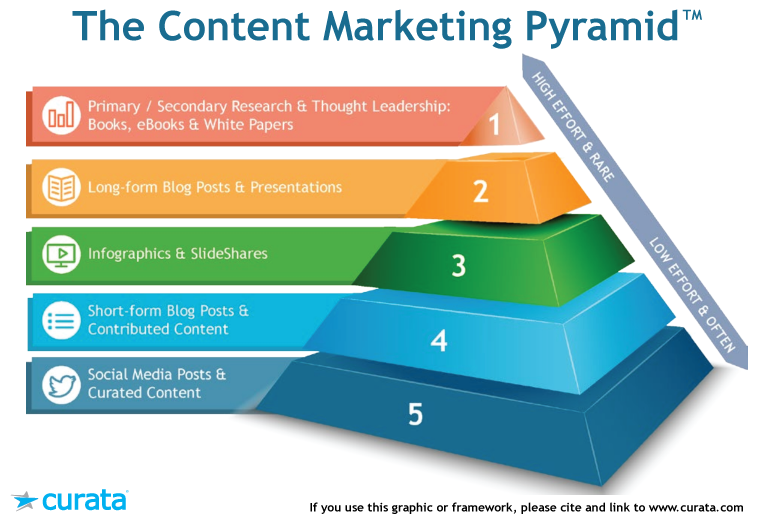
The typical ways that you’ve probably heard about using content curation might be in the form of weekly curated blog posts or weekly editorial email newsletters.
Those are great ideas and they should definitely be implemented.
But I want you to realize that the way that Neil uses content curation is completely different from these methods.
He isn’t using it as a separate tool to create the above types of content.
He is using it as an integrated content creation method.
Keep reading and I’ll explain what I mean.
How Neil Patel Uses a Hybrid of Content Curation and Content Creation to Create Blog Posts and Articles That People Love
Instead of just using content curation as the primary way to put together a blog post (like most people do), Neil uses content curation as a part of his content creation process itself.
He has morphed the two together into a hybrid form of content curation and creation.
The way he has done this and the results that he’s gotten from this hybrid method are amazing.
Let me share some powerful ways that he is using content curation as a part of his content creation.
4 of Neil Patel’s Best Content Curation “Tricks”
Neil is extremely smart. He isn’t just randomly curating content.
He is using content curation as a way to strategically build quality links to his content.
And the amazing thing is that he’s doing this without having to write 100%, fresh content.
If you keep reading, then I’ll show you how you can do the same thing by revealing four of the best techniques that he uses.
(*I’ve learned these things from observing his techniques in action and from reading posts he’s written about this.)
1. He links to other people’s infographics.
Did you notice the parts I bolded?
He uses graphical information for three important reasons:
- Because this provides information in a powerful form that his readers will like.
- He doesn’t have to labor over creating these graphics.
- He also uses them because they are powerful traffic generators.
In other words, he knows these will generate traffic to his site, because of these two truths about infographics:
- If you use someone’s infographic, then the person or company that created the graphic will most likely share it.
- If his readers like a particular graphic, then they will share the whole post that you’ve embeded the infographic in.
2) He mentions other people and businesses in all of his posts.
He doesn’t just use infographics. He also makes sure to mention many different people and/or businesses in each of his posts.
Take a second to look at the infographic below.
And when you do, pay special attention to #6 on the list…
(NOTE: This infographic above is based on an interview that Neil did with Zentrepreneurs, which is a Business Mastermind designed by Mindvalley Founder, Vishen Lakhiani. You can watch video of the interview here.)
Did you notice the quote that gives the reason WHY he mentions other people in blog posts?
He says, “Let people know when you’ve mentioned them in your posts. 20-30%+ will retweet and share.”
Neil mentions people in his posts, because a good amount of them will share those posts and link to them.
This is a really ingenious method!
In fact, I bet this is the same principle that Reader’s Digest harnessed when they published the lengthier article at the end of each issue.
What do I mean?
I guarantee that if I was an author and my book was featured as that article at the end of Reader’s Digest, I’d promote it everywhere and anywhere!
3) He focuses on curating viral content.
Neil doesn’t just curate any old content. He focuses on curating popular content.
Why does he do this?
He does this to build trust.
Neil says it like this, “potential clients who regularly benefit from your content curation will come to trust you.”
He finds this information by going to Google and typing in the keyword(s) or headline that he wants to write about.
An example he uses is that if he wanted to write a post on “blogging for beginners”, then he’d search that phrase on Google.
Just by doing that, he’d be able to instantly find 4 great pieces of content that he could link to.
4) He wraps it all up in his own content and with his own personality.
No one would be reading or sharing Neil’s posts if all he was doing was randomly curating links into a boring generic blog post.
What makes Neil’s posts stand out is the fact that he always uses his personality and shares his own powerful ideas in his posts.
Content curation is only used as a supplement for the ideas and thoughts that he wants to share.
And he always weaves in any curated links, graphics or information into his own content in a really compelling way.
That’s what makes his content so powerful and shareable.
Patrick Armitage talks about the importance of personalization in an article on Hubspot.com called 11 Content Curation Tools Every Marketer Needs.
He says…
“The personal touch creates a unique bond between curator and reader that aggregators haven’t figured out how to humanize or duplicate yet.”
– Patrick Armitage
If it wasn’t for this “personalization factor”, then Neil’s content curation wouldn’t be as powerful or effective.
If you are going to use his method, then remember that personalizing your content is the key to it working powerfully.
4 Great Examples of People and Companies That Are Using Content Curation in a Similar Way
I don’t want you to think that Neil got lucky using this hybrid method or that he is an exception to the rule.
There are plenty of others who also use content curation and creation together and have also seen some great results.
Let me give you four examples (two individuals and two companies) of others using his methods. You can then check out their work and see how they implement this content curation method in their own unique ways:
-
Sujan Patel

Sujan is the co-founder of Content Marketer & Narrow.io and the author of the new book Content Marketing Playbook: Master the Art of Content Marketing.Sujan uses a content curation and creation hybrid style that is very similar to Neil’s style. He creates great content while weaving in helpful curated content. But his content stands out in unique ways, because of his unique personality and the insights he adds.
You can check out his post A Data-Driven Approach to Going Viral for an example of the way he personally uses this method.
-
Buffer

Buffer uses content curation mixed with content creation all the time. In this post of theirs called The Busy Person’s Guide to Content Curation: A 3-Step Process for Your Blog, Newsletter, or Timeline they provide great information of their own, as well as linking to an example of content curation from 99u.com, an in-depth guide on content curation from SearchEngineJournal.com, and links and information to other sites. -
theSkimm.com

theSkimm is an email newsletter that curates the news of the day. But they don’t just put together a list of news stories. That would be boring. Instead they add their personality to the curated content in order to make the content more interesting and exciting.Here’s how they describe themselves, “We’re the daily e-mail newsletter that gives you everything you need to start your day. We do the reading for you – across subject lines and party lines – and break it down with fresh editorial content.”
-
Brian Clark – “Further”

Many of you probably know Brian Clark from Copyblogger or RainMaker.fm. But what you might not know is that Brian has created a whole new site called “Further” that he uses to harness the power of content creation and curation.He has a newsletter at Further.net in which he sends out personal development articles on areas such as money, health, etc.
But he doesn’t create all of the content on his own. No. Instead he curates much of it from books and articles that he is reading and he adds his own personality and ideas to it.
This is how Brian describes it, “Further is a once-a-week email newsletter that helps you maximize your purpose, performance, and potential. You’ll get the best hand-picked tips, trends, stories, and science that enhance your health, wealth, and wisdom – without the noise and fluff.”
So do you see?
Neil’s method (combining content creation and curation together with your personality and ideas) is being used by others companies and they are all seeing success with it.
And if they can use this method, then so can you.
If you’d like a way to visualize this process, then check out this graphic from SocialBites.com…
4 Tools You Can Use to Help You with Content Curation
1. Google Search
As you saw above, Neil uses Google search for content curation and it’s a great place for you to begin too.
2. Create a list of “Go to” sites
Michael Brenner has created a list of sites that he regularly visits to find great information. These include sites such as: The New York Times, Hubspot, and other top sites. He then uses them as his source for important information he can write about or link to.
This is a great idea! I have done the same thing and I’d encourage you to do the same too. If you need help getting your list started, then check out Michael’s list here: The 30 Best Content Curation Resources for Marketers and Business Pros.
3. Create a “Google Alert” for your keywords
Did you know that you can go to https://www.google.com/alerts and set up an alert for any keyword(s) you choose? Then Google will email you links to any content that uses these keywords.
Setting up a Google alert is easy:
I) Click on the Google Alert link above.
II) Type in your keyword(s). Let’s say they are “content curation”.
III) Click on “Show Options” next to the “Create Alert” button.
IV) Choose the options you’d like (Frequency, Sources, Languages, and Region).
V) Now click “Create Alert”. You’re ready to go!
You’ll now automatically be sent articles on the keywords that you chose.
(NOTE: You can do this for content you always want to search for and/or for content you know you will be writing about in the next month.)
4. You can also use other tools to search for content for you.
Google Alerts isn’t the only tool you can use to automatically find content for you to curate.
Here are a few of the other tools you can use: Spundge.com, Kuratur.com, and NetVibes.com.
If you want to know about more tools, then check out Susan Gunelius‘ Forbes article called 5 Ways to Use Content Curation for Marketing and Tools to Do It.
Just Make Sure You Use Content Curation in an Ethical Way
Using content curation is an important tool that can allow you to create powerful content that helps people and is widely shared.
But please make sure that you use it ethically.
If you want some great tips on how to curate content in an ethical way, then check out this guest post that Pawan Deshpande (CEO of Curata) wrote for ContentMarketingInstitute.com called Is Your Content Curation Ethical? A 10-Step Checklist.
2 Key Ways to Use Content Curation in an Ethical Way
If you want to use content curation ethically, here are two things to keep in mind:
1. Make sure that you always give the original content creator credit.
You can do this in multiple ways: mention the name of the author of the original content, mention the title of the original content, or mention the site that the content is from.
Just make sure that no matter which one of these ways that you use that you always provide a link back to the original piece of content!
2. Never use all of their content in your post.
Using a snippet of their content is fine. Using their whole blog post with your name on it isn’t!
The purpose of content curation is not to steal content from others.
It’s to bring to the attention of your audience some valuable information that can help them.
(They can’t find it all on their own. There’s too much content out there! That’s how you as a content curator become an asset to them.)
The Problem with Formulas
In my book 51 Content Marketing Hacks, in a chapter called The 12 Most Effective Ways to Create Irresistible Content (originally written for 12Most.com), I mention the problem with formulas such as the one I’ve revealed today.
I say, “There is a common problem with formulas. The problem is that people learn the elements of the formula, but they don’t learn the right implementation of the formula.”
Not only is that a problem, but the other problem is that people don’t practice any formula long enough to make it their own.
Later I say, “Keep practicing and perfecting the implementation of this formula. Make it your own. And who knows? Maybe one day someone will ask you to reveal your formula!”
I am showing you Neil’s method, so that you can learn from it and figure out ways to implement it in your own creative way.
Creativity is the key to standing out in any niche.
You will want to take this idea, practice implementing it, and then tweak it and make it your own!
Speaking of creatively using content curation…
I used a curation method to produce my book 51 Content Marketing Hacks. You see, I took blog posts that I’d written on my own site and other sites and I curated them all together in this book under the “Content Marketing Hacks” theme.
If I can use content curation like this – utilizing my own content – then you are only limited by your own imagination.
By the way, if you want to see one final example of how to use Neil’s method, then read through this post again.
In case you didn’t notice, I implemented all four of his “tricks” in this post! (See if you can see where/how I implemented each of his methods.)
- How many of the four “tricks” can you find in this post (and where are they)?
- What other methods of Neil’s have you noticed him use? Have you tried any of his other techniques?
Leave your answers in the comments below.
Originally titled “The Powerful, Unique Way Neil Patel Uses Content Curation to Create Irresistible, Viral Blog Posts” and published on recessionsolution.com. It is republished here with permission
Additional/Lead image: Copyright: ‘http://www.123rf.com/profile_rawpixel‘ / 123RF Stock Photo
Scott Aughtmon
Latest posts by Scott Aughtmon (see all)
- Influencer Marketing? How the Potato Was Made Popular - September 29, 2017
- What Content Marketers Can Learn From An 8 Year Old Boy - May 12, 2017
- Content Marketers: This is How Your Prospect’s Brains React To Stories - December 7, 2016

